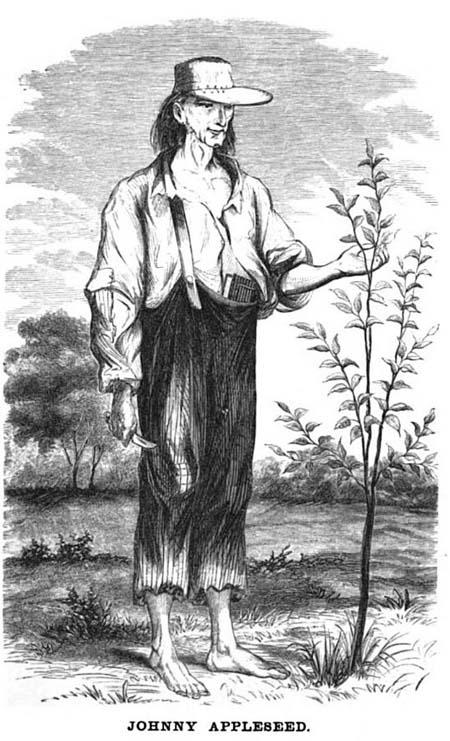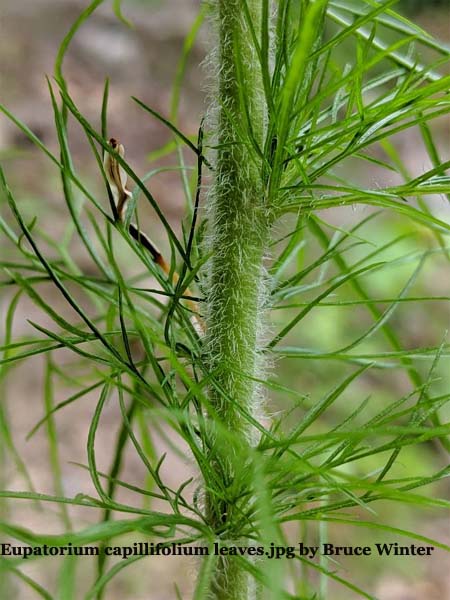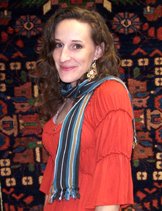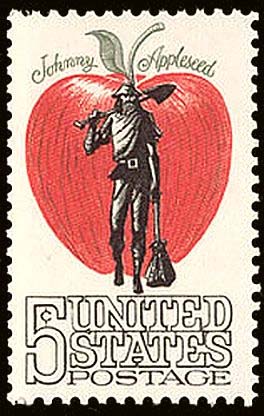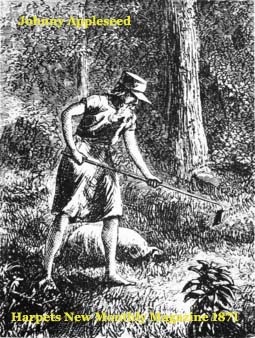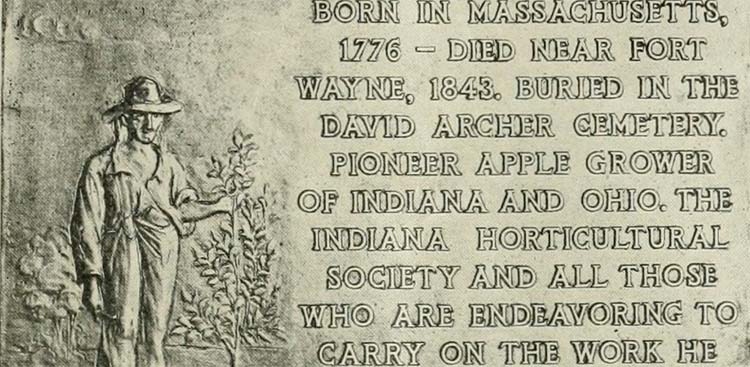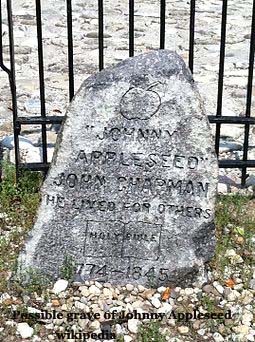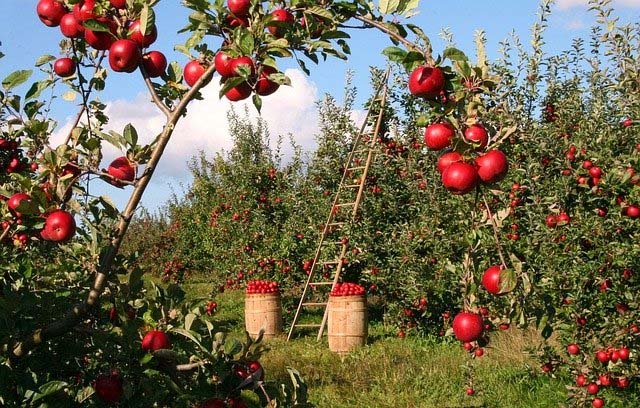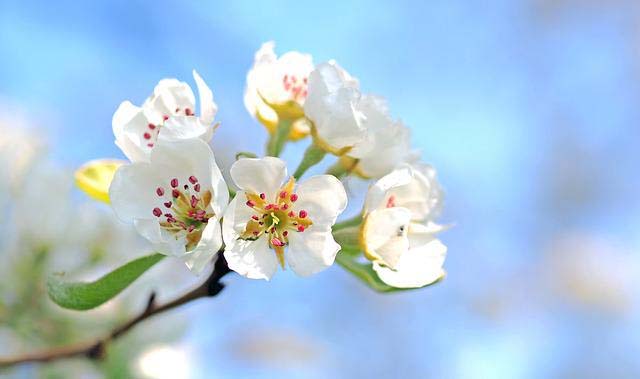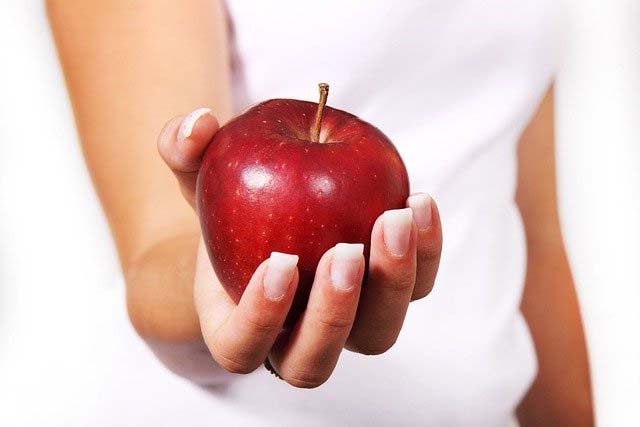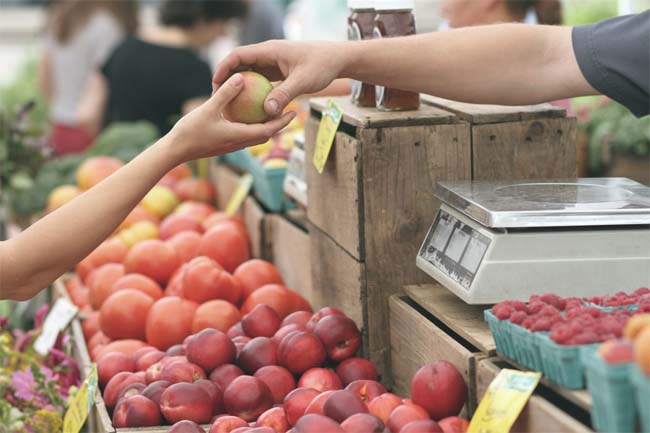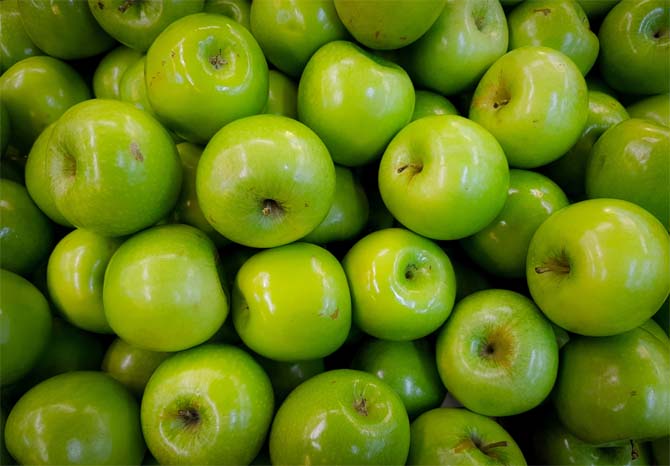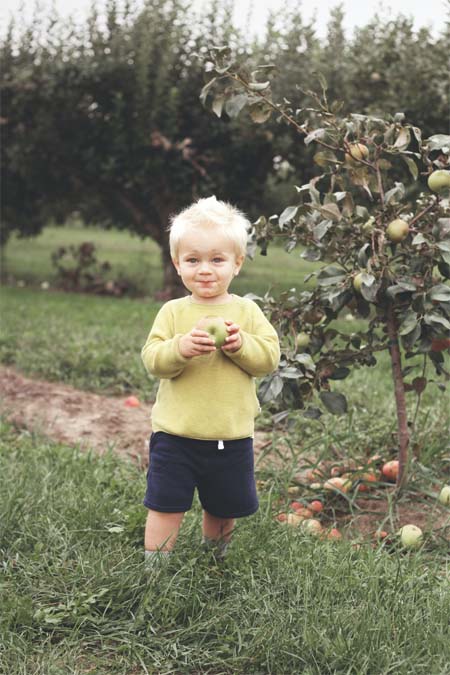JOHNNY APPLESEED
Few Americans have grown to adulthood without learning the story of Johnny Appleseed. His real name was John Chapman and he was born on September 26, 1774 in Leominster, Massachusetts. The street where he was born is now called Johnny Appleseed Lane.
He was responsible for creating apple nurseries in large parts of Pennsylvania, Ohio, Indiana, Illinois, and Ontario as well as the northern counties of present-day Virginia. Several states and towns in the Northeastern and Midwestern states pay homage to him with statues and festivals in his name. Parks, schools, nurseries, newspapers, and retail stores are still witness to his influence.
September 26 and March 11 are sometimes celebrated as Johnny Appleseed Day. The September date is Appleseed's acknowledged birthdate, but the March date is sometimes preferred because it falls during planting season.
WHO WAS JOHN CHAPMAN
(JOHNNY APPLESEED)?
ECCENTRIC or KNOWLEDGEABLE NURSERYMAN?
John Chapman or Johnny Appleseed was often described as an eccentric, but he was actually a knowledgeable nurseryman who assisted farmers in establishing countless apple orchards throughout the Midwestern states. As a young man, he began his apprenticeship with an orchardist who grew apples. This apprenticeship inspired Chapman's life journey of planting apple trees.
Although the popular image of Johnny Appleseed is that he spread apple seeds everywhere he went, the fact is he was an insightful businessman. He planted nurseries rather than orchards and built fences around them to protect them from livestock. He would then leave the nurseries in the care of a neighbor and would return every year or two to tend each nursery.
Chapman would also travel west ahead of the wagon trains and pioneers. He would file land claims, create nurseries with his seeds, and tend them until settlers arrived. Then he would sell the land or just the trees for a profit.
PREACHER
Chapman was also an itinerant preacher. He was deeply religious and believed in following the teachings of the New Church or Swedenborgianism (a Christian denomination influenced by the writings of scientist and mystic Emanuel Swedenborg). This belief contributed to his remaining unmarried, living a nomadic life by choice and owning only the clothes on his back and bags of apple seeds. He also wore a tin utensil on his head which served as both a cap and a mush pot or stew pot.
As a follower of Swedenborg, he believed that the more he endured in this world, the less he would have to suffer and the greater would be his happiness in the hearafter. He believed he would find his soulmate in heaven, if she did not appear to him on earth. He preached the gospel to settlers, handed out Swedenborgian literature, and befriended Native Americans and converted many of them. All this while planting apple nurseries.
Despite his image as a preacher, most of his seedling sour apples were used for hard cider or apple brandy. This was because Johnny Appleseed did not believe in the grafting required to make sweet varieties. Chapman made sure he was present when the farmers pressed their apples in the fall so he could collect the discarded seeds. He then washed and dried them, thus having another supply for his next orchard.
JOHNNY APPLESEED STORIES
Many stories abound about the journeys of Johnny Appleseed and his kindness to all he met, even animals and insects! Here are a few:
- It was said he heard that a horse was about to be put down. He bought the horse and some grassy acres and turned it out to recover. The horse did recover, and Chapman gave it to someone needy, but not before he exacted a promise to treat it humanely.
- He once extinguished a campfire so as not to harm a mosquito! He felt it was wrong to destroy any of God's creatures for his own comfort.
- One time, he supposedly made a campfire in a snowstorm at the end of a hollow log in order to pass the night. However, when he found out it was occupied by a bear and cubs, he removed the fire to the other end so as not to disturb the bear and slept instead on the snow in the open air.
- Another story tells of a wolf starting to follow him after he healed its injured leg.
Unfortunately, Chapman also planted Dogfennel in his travels which he believed to be a medicinal herb but, in reality, it can become an aggressive and poisonous weed. (However, an essential oil extracted from Dogfennel can be used medicinally as an anti-fungal.)
REMEMBRANCES OF THE LIFE and WORK OF JOHNNY APPLESEED
John Chapman, known in legend as Johnny Appleseed, was the original environmentalist. Below are some of the ways he is honored, and his work is celebrated:
- 1880. Abolitionist author Lydia Maria Child mythologized Johnny Appleseed in the following poem:
In cities, some said the old man was crazy
While others said he was only lazy;
But he took no notice of gibes and jeers,
He knew he was working for future years...
And if they inquire whence came such trees
Where not a bough once swayed in the breeze,
The answer still comes, as they travel on,
'These trees were planted by Apple-Seed John.'
- 1921 and 1928. The American song poet Vachel Lindsay published several poems about Johnny Appleseed.
- 1933. The poets Rosemary Carr Benét and Stephen Vincent Benet mythologized Appleseed in a children's poem book named 'A Book of Americans.'
- 1948. Appleseed is featured in an animated musical segment in the Disney movie 'MelodyTime,' titled 'The Legend of Johnny Appleseed'.
- 2008. The Fort Wayne Wizards, a minor-league baseball club, changed their name to the Fort Wayne TinCaps and in their first season with the new name in 2009, they won their only league championship. The name 'Tincaps' refers to the tin hat (or pot) which Johnny Appleseed allegedly wore. The team mascot is named 'Johnny'.
- 1962 to 1980. A high-school athletic league made up of schools from around the Mansfield, Ohio, area used the name the 'Johnny Appleseed Conference.'
- 1966. the U.S. Postal Service issued a 5-cent stamp commemorating Johnny Appleseed.
- 1984. Jill and Michael Gallina published a biographical musical, titled 'Johnny Appleseed.'
- 2016. John Chapman appeared in Tracy Chevalier's historical fiction novel 'At the Edge of the Orchard.'
- A large terracotta sculpture of Johnny Appleseed, created by Viktor Schreckengost (1906-2008), adorns the front of the Lakewood High School Civic Auditorium in Lakewood, Ohio. The local board of education deemed Appleseed too 'eccentric' a figure to grace the front of the building and renamed the structure, 'Early Settler.' Students, teachers, and parents alike still call the sculpture by its intended name, 'Johnny Appleseed'.
- A memorial in Spring Grove Cemetery in Cincinnati, Ohio, stands in Section 134. There can be found a circular garden surrounding a large stone with a bronze statue of Chapman on it with his face looking skywards and holding an apple-seedling tree in one hand and a book in the other. A brief biography and eulogy of Johnny Appleseed is also included.
- One of two Johnny Appleseed Museums in the world open to the public is maintained at Urbana University in Urbana, Ohio. It is The Johnny Appleseed Educational Center and Museum. A number of services for research are offered there including a national registry of Johnny Appleseed's relatives. The goal of the educational center and museum is to give people the opportunity to study the life of Johnny Appleseed in the belief it will share his appreciation of education, his country, the environment, peace, moral integrity, and leadership.
SIMPLE WALDORF SALAD RECIPE
Although Johnny Appleseed might not approve of this recipe because it uses grafting to get sweet apples, the Waldorf salad features a colorful selection of apples. It makes a festive autumn side dish, for dinner, or a picnic, adding color to any menu. The following is just one variation. Some recipes include other items such as red or green grapes, raisins, bananas, yogurt, etc.
Ingredients
2 cups apples - red or mixed colors
1 cup celery
3/4 cup walnut pieces
1 cup miniature marshmallows
1 to 1 1/2 cups of poppyseed dressing (1 cup mayonnaise, 3 tablespoons sugar, 3 tablespoons of milk and 2 teaspoons lemon juice (optional)
Directions
Cut apples into 1/2 inch cubes and set aside.
Cut celery into small pieces. Cut any large nut pieces.
In a large bowl, mix the ingredients thoroughly.
Pour the dressing over the mixture and stir until all ingredients are moist but not dripping.
Makes four to six servings.
Enjoy!
"The Cleanest Clean You've Ever Seen."
by
ABC Oriental Rug & Carpet Cleaning Co.
130 Cecil Malone Drive Ithaca, NY 14850
607-272-1566
